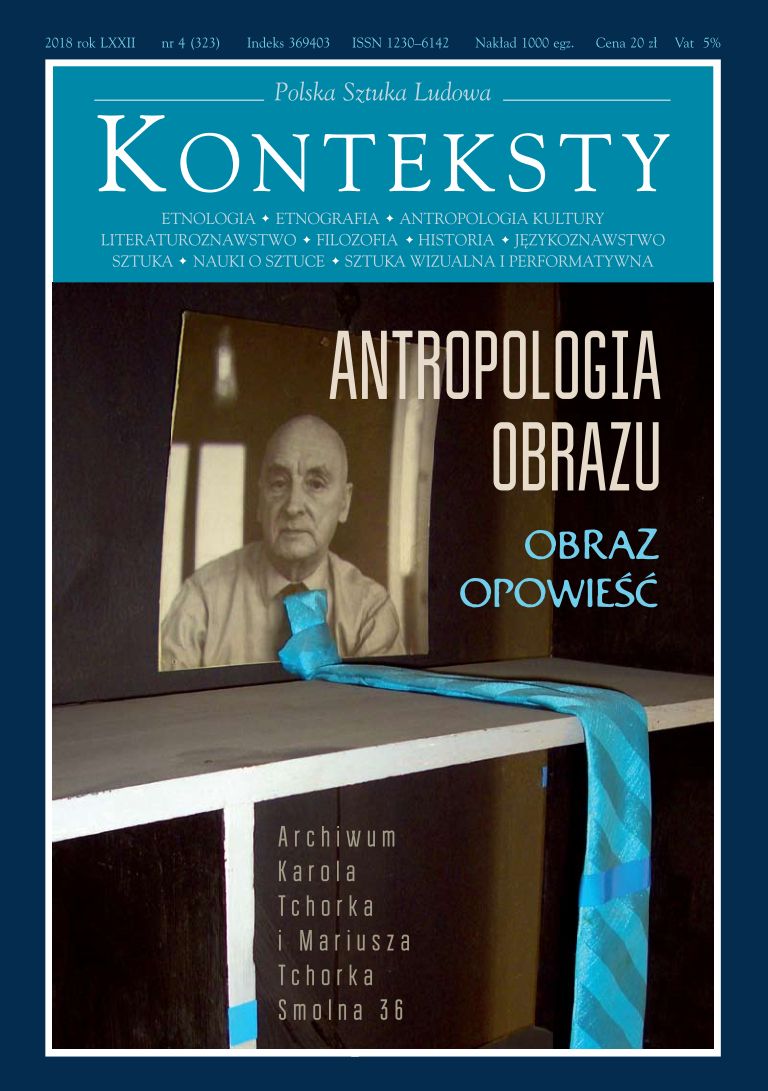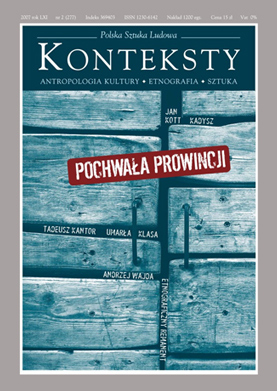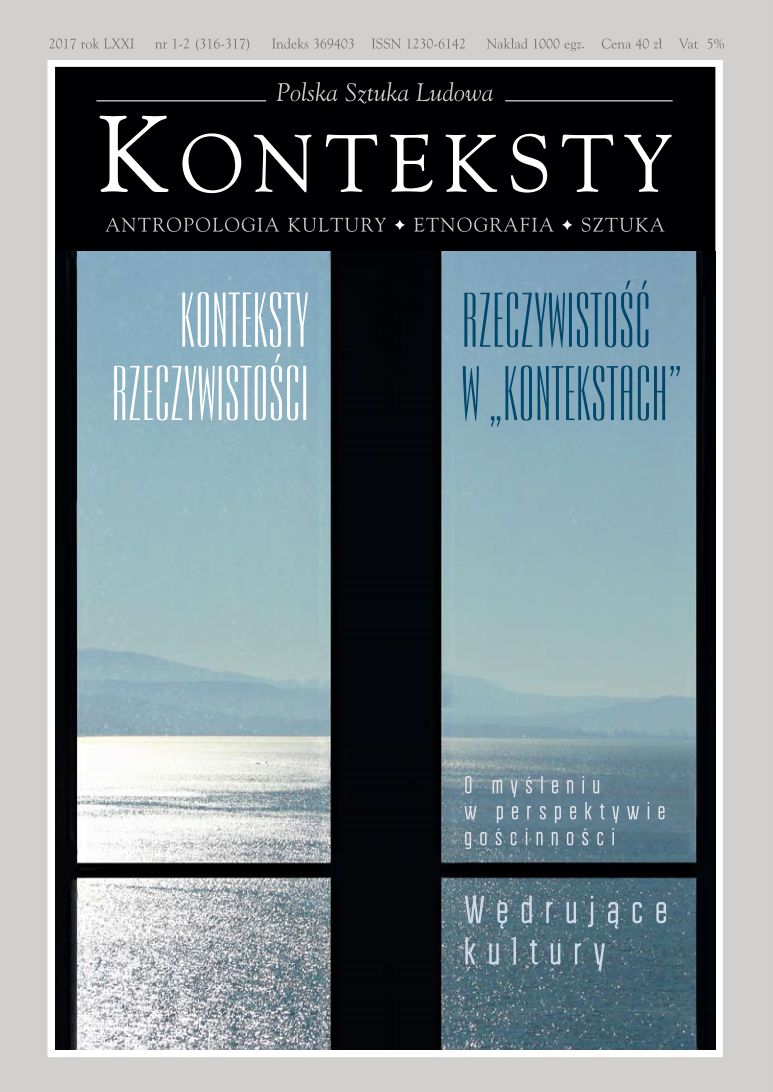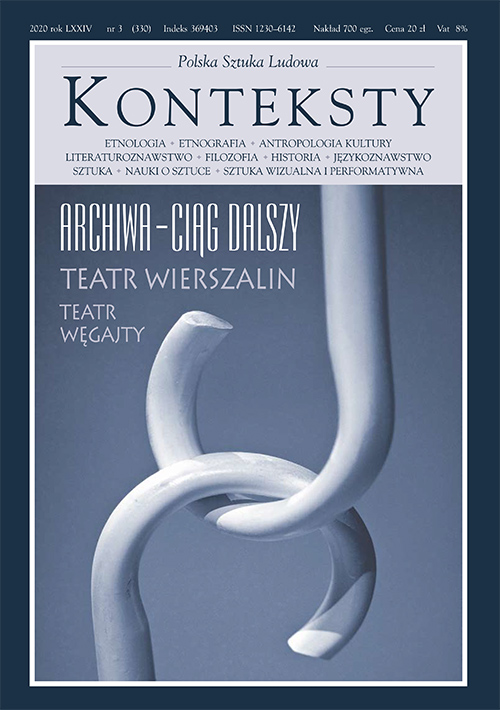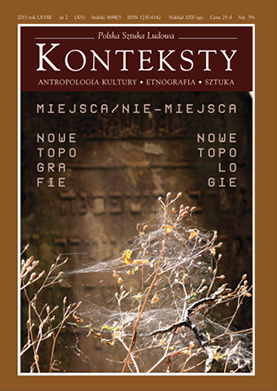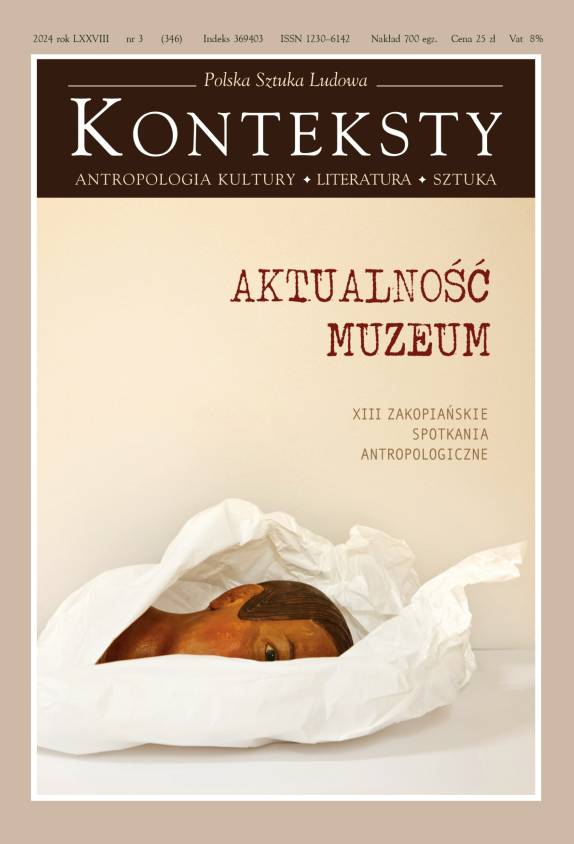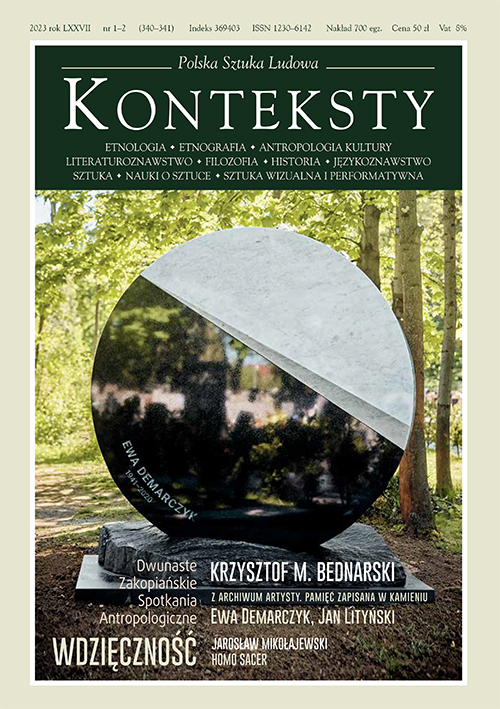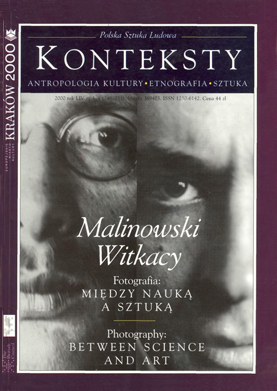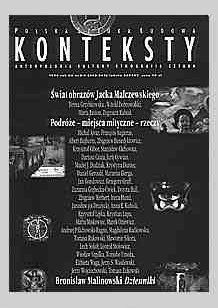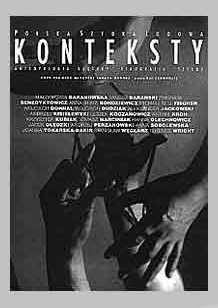Issue 2003/3-4 (262-263) -

| Mikołaj Gumilow | 4 | |
| Anna Beata Bohdziewicz | Photographs from a Journey  | 5 |
The author registered her journey to Afghanistan, India and Nepal, made years ago, by means of "mundane" notes and n the most detailed diary. | ||
| Ryszard Kapuściński | ||
| Dariusz Czaja, Zbigniew Benedyktowicz | On Memory and the Threats Facing It. An Interview with Ryszard Kapuściński  | 12 |
The conversation with the outstanding Polish reporter Ryszard Kapuściński broached several motifs and themes associated with memory. The opening reflections concern memories of the birthplace and the first remembered images, sounds and words. Kapuściński, who was born in the provincial town of Pińsk (the Polesie region), recalled moments spent in his home town and reconstructed the phenomenon of private memory. He went on to consider biographic memory and, while discussing the book Podróże z Herodotem (Travels with Herodotus), indicated the important role played in his writings by Herodotus and his writings. The third theme pertains to threats encroaching on memory. Here, Kapuściński pointed out three basic sources existing in the Western world: the appearance of mechanical carriers of memory, the excess of information in contemporary reality, and the acceleration of the historical process - each of those issues is subjected to a thorough analysis. | ||
| Franklin R. Ankersmit | The Sublime Dissociation of the Past: or how to Become what One Is no Longer  | 25 |
Forgetting has rarely been investigated in historical theory. Insofar as it attracted the attention of theorist at all, forgetting has ordinarily been considered to be a defect in our relationship to the past that should be overcome in one way or another. The only exception is Nietzsche who so provocatively sung the praises of forgetting in his On the Use and Abuse of History (1874). But Nietzsche's conception is the easy victim of a consistent historicism and therefore in need of correction, four types of forgetting are identified in this essay, central in the essay's argument is the fourth type. This is the kind of forgetting taking place when a civilisation "commits suicide" by exchanging a previous identity for a new one. Hegel's moving account of the conflict between Socrates and Athenian state is presented as the paradigmatic example of this kind of forgetting. Two conclusions follow from the analysis of this type of forgetting. First, we can now understand what should be recognized as a civilisation's historical sublime and how the notions of the historical sublime and of collective trauma are related, second, it follows that myth and (scientific) history do not exclude each other; on the contrary, (scientific) history creates myth. This should not be taken to be a defect of history, for this is precisely how it should be. | ||
| Kerwin Lee Klein | On the Emergence of Memory in Historical Discourse  | 42 |
This article comes from: "Representations" winter 2000, No 69. | ||
| *** | ||
| Katarzyna Kaniowska | Memory and Anthropology  | 57 |
Interest in memory appeared in anthropology together with a special auto-reflection whose outcome assumed the form of a change of the paradigm. The emergence of such transformations, reinforced by the powerful impact of hermeneutic, became the reason why reflections on knowledge and cognition, borrowed from the adherents of hermeneutic, inclined anthropology to resign from the effort of building successive theories of culture for the sake of a more in-depth self-knowledge, well aware of the specificity of anthropological cognition. It now became necessary to discuss anew the old problems of the objectivity of cognition, the object and the subject, sources, interpretations and the perception of the significance of such components of cognition which the old paradigm did not recognise or outright neglected. The text, rhetoric and narration, treated as important elements of the procedure of cognition, generated interest in the determinants of the dialogue, the discourse, and the specificity of anthropological knowledge. Performed from the perspective of the new paradigm, the analysis of the processes of cognition in anthropology disclosed that the heretofore applied manners of explanation must be reconstructed and expanded. If the purpose of the explanation is to consist of comprehension then one should permit those elements which up to now have been seen as extra-logical, to participate in the explanation. In this instance, the author would be inclined to recognise the inclusion into cognition of extra-logical elements of cognition, and the granting of equal rank to subjectivism, envisaged as one of the most important features of contemporary anthropology. The recognition of subjectivism as an additional value and the process of noticing that this value appears in a dialogue which builds the knowledge of both its participants is prominent, since by doing so one notices that anthropological knowledge stems from a subjective experience, interpretation and understanding of the world by the persons under examination, as well from the subjective experience and interpretation (and sometimes understanding) of the world by the researcher - both his own world and examined reality. It is the different manner of thinking about anthropological cognition and knowledge which stirred the anthropologists’ interest in memory (primarily semantic). The discussions about memory conducted in contemporary anthropology demonstrate clearly its assorted interpretations. The author would like to draw attention to three manners of comprehending memory, fundamental in his opinion, which come to the fore in such discussions, and to indicate the ensuing problems. Those three manners of analysing memory and its role in cognition appear in present-day anthropology in accordance with one of the following convictions: memory as the source of anthropological knowledge; memory as the object of the knowledge possessed by anthropologists; and memory as a tool of cognition. | ||
| Czesław Robotycki | Remembrance of Peoples Poland - an Anthropologist and the Experiences of the Past of Own Culture  | 66 |
Once the epoch of the People's Republic of Poland receded into the distant past there emerged differentiated stands vis à vis this historical fact, together with attempted descriptions and a documentation of the systemic reality of bygone days. The author maintains that there exist two levels of description - one which appears in official censored publications, wherein the criterion of the selection of facts lay in the class aspect, and a second one, suggesting the swiftest possible riddance of this legacy, which either entails remembering it as part of history or the obliteration and liquidation of all traces of the infamous past. C. Robotycki dealt with the nature of such history and its authors, and analysed the historical, ethnological and sociological perception of the phenomenon of People's Poland, based on multiple publications, scientific studies and reminiscences. | ||
| Dariusz Czaja | The Black Box. On the Idea of Absolute Memory  | 71 |
Can one remember everything? What does it mean to "remember everything", and what is the sense of such an activity? Upon the example of two literary texts, the author of the article tried to resolve those questions - by resorting to All the Names by José Saramago he delved into the concept of the Archive, and by alluding to the Encyclopaedia of the Dead by Manilo Kis he tried to disclose the idea of the omniscient Encyclopaedia. Both those institutions harbour the ambition of recording the existence of every human creature, and are overwhelmed by a desire not to ignore a single one. By referring these literary creations to St. Augustine's brilliant reflections about memory (Confessiones) the author inquired about the conditions for a possible emergence of the idea of absolute memory. He tried to answer a question about such a manner of constructing of the human intellect which would make possible the emergence of this essentially metaphysical idea. | ||
| Waldemar Kuligowski | On History, Literature, the Present and Other Forms of Forgetting  | 79 |
The point of departure for the reasoning presented by the author is that culture is, first and foremost, memory, the mechanism of storing and recreating certain models and experiences as well as assorted types of knowledge. Today, this situation is undergoing a profound change. Research conducted by historians has shown that historical consciousness expresses not so much familiarity with facts as their interpretations; subjective visions of reality include contemporary literature (at least from the time of Proust) and photography. Moreover, the social sciences describe present-day society as "nowist", "generation now" or "generation X", distinctly indicating the severance of ties with history, continuum and cultural memory. The author concludes that social life - the media, production, politics and love - are governed by temporariness and sometimes by outright disposability. Memory has become an embarrassing, provincial and old fashioned feature, neither fashionable nor trendy. | ||
| Sławomir Sikora | "Memory: the Space in Which Events Recur". On Photography  | 85 |
Smoke by Paul Auster and Wayne Wang (1995) apparently embarks upon a theme similar to Roland Barthes' Camera Lucida (1980), and tackles it anew, an approach that could be concurrent with Auster's opinion, which has served as the title of the essay. The author tried to prove that the photographic motif which does not appear in the foreground in Smoke, is actually essential for this film. Moreover, it could be treated as a sui generis creative expansion of certain experiences described by Barthes in Camera Lucida (the existence of such a relation is also indicated by several motifs in Barthes' biography). The essay, however, is not concerned merely with following the genealogical link between the two works, but with the ideological bond. The "adventure" described by Barthes, i. e. seeing a photograph of his deceased mother, could be treated as a not entirely successful "experiment" of repeating the experiment with involuntary memory, described by Proust. In this respect, the "ritual" presented in Smoke, which consists of an encounter with a photograph of the deceased wife, appears to he much more complete and successful. | ||
| Marcin Brocki | The Semiosis of Memory in Ethnography  | 92 |
In recent years, auto-narration (various "remembered texts") in ethnography has been transferred from its former role of evidence to that of ethnographic material. In this fashion, memory has been treated as a tool for a semiosis of the past which, in addition, operates on both sides of research-interpretation, i. e. the researched and the researcher. In thus conceived memory, authenticity, envisaged as the expression of truth, becomes a challenge. Accepting the initial thesis maintaining that ethnography consists of the creation of texts about texts, one may observe the mechanisms of an autobiographical reconstruction of the past, those "remembered texts", perceived as the manners of its textualisation (and thus operationalisation), in order to disclose the creation of the world depicted in the research praxis of ethnography. In contemporary anthropology the memory of researchers and, hence, proof of that which "is really taking place on the spot", became the same sort of data as all others. At the same time, the investigators had lost the power to proclaim that in those instances where personal experience and memory participate in a slight degree in the construction of data we obtain superior data, as well as to make a contrary statement, namely, that we achieve such data in those cases when we permit personal experience and memory (also native) to speak independently (which is not a only naive, but also an erroneous belief). | ||
| Magdalena Sztandara | On the "Ethnographic Quality" of Photography  | 95 |
The "ethnographic quality" of photography consists not only of the effort of documenting details of everyday life, but also of the fact that, on the one had, photography appears to recreate the relations between man and the word and, on the other hand, it records emotions. The author of the article is interested in photography which documents the outline of the departing world and registers the assorted manners of viewing it and its conceptualisation. The ethnographic aspect is also a task for the spectator, a game which he could conduct with an unknown world. Our memory stores photographic stills which we use to construct an image of the past. Photography urges that it may survive, so that it could perpetually revive a bygone world. | ||
| Marcin Kafar | On the Essence of the A leg to Stand on by Oliver Sacks and To jest wasze życie This is Your Life by Małgorzata Baranowska  | 102 |
An analysis of two examples of the so-called literature of malady, namely, by the American neurologist Oliver Sacks and To jest wasze życie by the Polish poetess Małgorzata Baranowska. Both books are interpreted as autobiographical testimony of the lives of the authors, who translated their own experiences of a lengthy illness (Małgorzata Baranowska) and suffering caused by a grave accident (Oliver Sacks) into literary imagery. Martin A. Kafar focused his attention primarily on indicating and defining the role played by literature and the Word as such, which in the face of an illness proved to be a significant heuristic measure (and contributed, i. a. to constructing knowledge about the illness) as well as a therapeutic and cathartic medium. In a wider context it is possible to connect them with art motifs encountered in situations of individual and social crises, which - in the opinion of the author of the article -could indicate the existence of a sui generis pattern of symbolic activity, revealed at the moment of man's opening to a different reality, whose distinct examples include illness. | ||
| Daniel Vogel | 114 | |
| Dipesh Chakrabarty | Who Speaks for "Indian” Pasts?  | 117 |
The problem of rewriting the history of the once colonial countries is one of the main concerns of the Subaltern Studies Group. Dipesh Chakrabarty , Professor of South Asian Studies and History at the University of Chicago and member of this group recalls at the beginning of his article an opinion that owing to the project of Subaltern Studies, "perhaps for the first time since colonization Indians are showing sustained signs of reappropriating the capacity to represent themselves [within the discipline of history]” . However, being a historian himself, he adds that although he finds the congratulation gratifying, it is premature. The main problem, according to Chakrabarty, is the perception of the academic discourse of history, which almost always treats "Europe" as "the sovereign, theoretical subject of all histories, including the ones we call 'Indian,' 'Chinese,' 'Kenyan,' and so on."The "other" histories somehow seem to belong to the "history of Europe" and thus are always in the position of subalternity. However, it is interesting to notice that Chakrabarty treats "Europe" (in his article "Europe" is always put in inverted commas) as some sort of abstract, "hyperreal" figure, "whose geographical referent remain[s] somewhat indeterminate." But it is this "Europe" that is often perceived as the cradle of ideas such as the nation state, citizenship or capital. Apart from being in the position of subalternity, the history and self-representation of the postcolonial countries had to face another problem. Imperialist and expansive Europe constructed certain metanarratives, in which the world was divided into the centre (Europe) and its peripheries. The centre celebrated the idea of the nation state, and as its influence on colonies lasted for centuries, the peripheral countries had to accept the view that the nation state is the most desirable form of political community. So if we consider the "Indian nation," for example, we will notice that it was divided into peasantry and "modern" elite. The desire to be "modern" resulted in, as Homi Bhabha justly called it, "mimicry" of European lifestyle, behaviour, fashion, but also of trends in literature and the subject of history. Thus "Indian" history, as Dipesh Chakrabarty put it, "even in the most dedicated socialist or nationalist hands, remains a mimicry of certain 'modern' subject of 'European' history and is bound to represent a sad figure of lack and failure." The author of the article, in his attempt to undermine the candour of the "universal" history, asks questions which for most Europeans may seem to be absurd: "Why is history a compulsory part of education of the modern person in all countries today including those that did quite comfortably without it until as late as the eighteen century? Why should children all over the world today have to come to terms with a subject called 'history' when we know that this compulsion is neither natural nor ancient?" The reason for such an attitude lies in the very nature of history, which became an excellent tool in the hands of European imperialism. Making an impression of objective and unbiased science based on the analysis of historical facts, the "European" history created certain metanarrative in which Europe was always presented in an idealised way. This narrative, however, was nothing but "a piece fiction told to the colonized by the colonizer in the very process of fabricating colonial domination." Dipesh Chakrabarty does not confine himself to the criticism of using history for colonial practices. In his project of "provincializing Europe" Chakrabarty claims that the "universal" history should be devoid of elements celebrating the idea nation state or citizenship and instead include chapters describing all the ambivalences, contradictions, the use of force, the tragedies and the ironies that have always attended it. The author realises that such a history will attempt an impossible, as it requires the academic discourse of history turn against itself. Nevertheless, he is convinced that the dream about history that is free from all the themes of citizenship and the nation state will last until these motives stop dominating the narratives of historical transition. | ||
| Peter Martyn | Return to India  | 133 |
This text amounts to a recollective account of the opening stages of one man's journey to the Indian Subcontinent some six months before the international terrorist attack on selected commercial and governmental establishments in the United States. Determination to follow the path of a traveller and avoid the most stereotypical behaviour and practices of western or westernized holiday-makers, fun seekers, ersatz spiritualists and hedonists entailed a heated baptism of being more solidly down and out than superficially 'hip' and 'with-it' in Delhi. While resorting to the fundamental abilities to observe, experience and describe, and thus discarding in the face of India's utter vastness the conventional methods of academic research, the visitor drew on the world-weary commentary to Louis Malle's documentary film of 1969 and the demonic writings of a non-resident Bombayite as principal sources of inspiration and insight. After four days of encountering the still overwhelmingly traditional Moslem, as opposed to modernizing Hindu, way of life in the Indian state capital, the traveller took advantage of the fabled British legacy of the impressively updated railway network to journey to the Punjab, which, alongside Kashmir and Bengal-Bangladesh, lies at the very core of the post-independence Hindu-Muslim Partition. Having made use of the mercifully uncommercialised Punjabi Hindu-Sikh and inevitably subdued Moslem ethno-cultural melange surviving in Amritsar as a watering hole before crossing the only open border check-point into Pakistan, the itinerant experienced something of a revelation in the Muslim Republic's second, but historically, culturally and intellectually its primary, urban centre: Lahore. The delayed adoption of 'new-age' capitalism and comparative underdevelopment of tourism as an industry left the wayfarer somewhat suspended in time between a world strongly reminiscent of so many of his forefathers and the new epoch of high-tech, internationalised 'economics' and globalite smash-and-grab trend setters. In view of the commitment made to journey around the main part of the subcontinetal delta during the month available to him, the traveller could remain no longer than five days in the city - a perfect time, nevertheless, to keep malaise, disenchantment or disillusionment well at bay - before recrossing the post-1947 Divide into Hindustan. The moral to this part of the adventure might be that some of the last remaining anthropologically and socially less tainted parts of the world are those which have managed to preserve something of their cultural identity by maintaining maximum distance and some form of constant resistance to what was once termed westernisation and is currently most typically defined as globalisation. The delayed sequel to this part of the story would have to end in the summer of 2003 in London, where, as a result of the virtual collapse of organised professional travel in Pakistan, the visitor's individual guide to Lahore is currently seeking work in any commercial enterprise that will employ him. | ||
| Jo Harper | Which Blair Project?  | 142 |
This paper is a shorthand summary of various ways in which the language politicians choose to use alters the symbolic terrain key political actors choose and are able to inhabitat. It looks at how by reworking language, politicians alter perceptions and even recollections of the past. It deals, if only in outline, with how (re)constructed political identity can reshape political action and possibly also political outcomes. The paper looks at the ways in which the British Labour Party under Tony Blair has since the mid-1990s sought, and largely succeeded, in reinventing the party's collective symbolic recollections, those parts of the collective political memory that defined what is was/is to be 'of Labour' and by so doing shifted the ideological debate, in so far as it stood, thus laying the ground for a fundamental realignment of British politics. | ||
| Tomasz Sikora | The Bwiti Initiation Rite  | 146 |
The author attempts to bring the reader closer to the impact which may be made upon cultural memory and inter-generational transmission by traditional initiation rites applying hallucinogenic substances and mirrors. The presented analysis refers to the rites of admittance to the secret Bwiti society among the Fang people in Gabon: myths concerning the origin of the hallucinogen (taberbathe iboga) and its psychopharmacological properties, as well the techniques of employing mirrors in ritual practices. | ||
| Ewelina Pawlus | Adjugated Elements. Earth and Fire in the Oeuvre of Władyslaw Hasior  | 150 |
Author discusses a heretofore insufficiently examined the range of Hasior's works associated with the use of unconventional artistic substance, such as energy, earth and fire. The example of St. Sebastian, In Memoriam of Hostages Shot in Nowy Sqcz (Golgotha), Fiery Pieta and Sun Chariot forms a basis for a presentation of the artist's pioneering approach: earth in Hasior's endeavours assumed the character of a casting mold and substance. In its structure, the artist carved an outline of the shape of the planned sculpture, reinforced the emergent form with iron rods, and poured cement, another substance with earth connotations. The obtained cast produced the effect of the "excavation-like and rough texture of the natural foundation from which it had been extracted". Into the indentations of the set cement mass the artist poured an inflammable substance thanks to which, after ignition, the sculptures attained their ultimate shape. Hasior discovered the inspiration for the technique of casting cementsculptures in the soil while visiting an abandoned cemetery in Aix-en-Provance which contains stone, man-shaped sepulchres dating from the Roman period. By resorting to such a drastic defiguration of the human figure, negating the canons of the beauty of man conceived as a perfect creature, Hasior referred to the events of the second world war and in particular to the execution of hostages in Nowy Sącz. In this fashion, his "land sculptures" became, in the opinion of the author of the article, tantamount to the raw art of Dubuffet and Wols, and especially the Hostages cycle by Fautrier (this thesis opposes the opinions voiced by certain critics who accentuated Hasior's precursory role in land art). The sculptures are a three-dimensional consequence of confrontations with the structure of the paintings by the aforementioned artists; they are also a statement about the human condition in the face of wartime atrocities, the voice of a generation which reached down to the "eschatological stratum connected with existential moods originating from the war - Tadeusz Brzozowski, Jan Lebenstein and Tadeusz Kantor, whose artistic declarations are reflected in the poetry of Tadeusz Różewicz, another representative of this generation. The analysis of the symbolic of the earth and fire elements embarks upon an attempt at interpreting the sculptures. It must be noted that only the Sun Chariot group remains distant from wartime events, and becomes, in the light of the suggested interpretation, a joyful work celebrating revitalisation, fertility and the life-giving forces of earth and fire. | ||
| Jerzy S. Wasilewski | The Travelling Ethnologist 4 - Who Says Bonjour to Whom on Mont Blanc? An Attempted Anthropology of Conventional Behaviour  | 165 |
An attempt at an anthropological reflection on the customary greetings exchanged by tourists hiking in the high mountains. How are we to interpret the tradition of saying bonjour, Grüss Gott or hello, so common along Alpine trails? Is it the symptom of an authentic feeling of a certain community in the conditions of a perilous wilderness, which must have been experienced by the first explorers? Or are we dealing with some sort of a cultural compulsion of creating if only a semblance of a perfect and friendly human community in an ideal paradise, as in the case of national parks? Or is this a case of hyper-civilised behaviour enforced by the all-prevailing elegance, as in the Swiss Alps? The most magnificent Alpine peaks become a backdrop for a new iconosphere (“shrines” - the works of modern sacral or metaphysical art, advertisements, omnipresent icons of consumerism, etc.), which outright endowed even the most exquisite mountains with additional sophistication, forcing us to retain conventional forms. | ||
| Piotr Szacki | To Remember  | 175 |
The presented text deals with "memory" and remembrance within the formula of a museum exhibition. Originally it was intended as a diptych, whose only realised fragment was "to have", devoted to testimonies of possession within the collections of an ethnographic museum. The autonomous topic of "memory" involves the category of time, and is associated with the phenomenon of “possession”. The meaning of commemoration may be discovered within the interpretation of objects and beyond the sphere of the commonplace interests of collectors. The article cites examples of carriers of information which constitute the message of the devised exhibition. They include photographs, especially family and of ceremonial groups, personal belongings, likenesses described as "portraits", inscriptions and signs displayed on everyday objects, monuments and terminological registers. Such a survey of material testimony reflects the intentions which brought them to life: the construction of a myth, the creation of evidence, the experiencing of an awareness of a "generalised" past, and the process of rendering precise the identity of an individual by placing it in time. | ||
| Iwona Święch | Chest  | 182 |
A spotted chest in the collection of the Museum of the Region of Kujawy and Dobrzyń - the only piece of furniture of its sort originating from this terrain - inspired the author to pursue new tracks and meanings in an attempt at discovering something long forgotten. The history of objects, which demonstrates the extent to which memory is an act of the imagination, can be enthralling. | ||
| *** | ||
| Stephanie West | Aristeas According to Herodotus  | 187 |
Aristeas was an Early Greek epic poet and an extremely mysterious figure, until recently regarded as a traveller and a "shaman". He was the author of the lost Arimaspea, used by Herodotus in his description of Scythia and neighbouring regions (book IV). Herodotus also told the story about the strange circumstances of Aristeas disappearance, his return six years later, yet another disappearance and rematerialisation after 240 years. S. West conducted a detailed analysis of the pertinent fragment from Herodotus, and upon its example demonstrated his methodology, which consists of a rationalisation and demythologisation of legends and tales. The ensuing conclusion made it possible to suggest theses relating to the character of Aristeas work conceived as a prototype of the Utopian voyage genre. | ||
| Jean Pierre Vernant | The Mythical Aspects of Memory  | 201 |
This article, already a classic, by one of the most acclaimed French Hellenists comes from the oft reissued Mythe et Pensée chez les Grecs. | ||
| David R. Lachterman | Noos and Nostos : The Odyssey and Sources of Greek Philosophy  | 213 |
Linguistic research has demonstrated a semantic link in archaic Greek between the words noos (intellect) and nostos (return). The author explores the presence of this connection in Homer's Odyssey and, at the same time, reveals its significance for the philosophical and literary notion of "the beginning". | ||
| Wojciech Michera | Lathestai. On the Temptation of Oblivion  | 217 |
The poetic word - whose persuasive impact brings to mind erotic temptation or narcotics - buries in "oblivion" the anxiety and anguish of painful contemporaneity: this is one of the prominent themes of archaic and classical Greek culture. The author presented it upon the example of the prologue to Theogony by Hesiod and selected motifs from Homer's Odyssey , concentrating predominantly on the complex and ambiguous relations between the categories of "oblivion" and "memory" as well as "truth" and "lies" in the domain of poetical praxis. | ||
| Włodzimierz Lengauer | 223 | |
| Włodzimierz Staniewski, Czesław Robotycki, Lech Robakiewicz, Robert Pawlik, Henryk Paprocki, Wiesław Juszczak, Bohdan Kos, Mariusz Dobkowski, Dariusz Czaja, Zbigniew Benedyktowicz | "The Reality of the Gods". A Conversation about Pani na żurawiach Lady of the Cranes, a Book by Wiesław Juszczak Warsaw  | 224 |
The discussion about the latest publication by Professor Wiesław Juszczak, the author of numerous books and dissertations on the history and philosophy of art, was attended by Włodzimierz Lengauer, a Hellenist, Henryk Paprocki , an Orthodox theologian, Bohdan Kos, a historian of cabalistic thought, and the anthropologists Zbigniew Benedyktowicz , Wojciech Michera and Dariusz Czaja. The speakers stressed the importance and originality of Juszczak's book not only within the context of Hellenistic studies but also for fundamental reflections concerning the relations between religion, culture and art. The participants of the discussion also indicated the fact that the author tackled a problem basic for Greek culture as a whole, namely, the conception of the deity and his relation towards the world. First and foremost, they noted that the examined dissertation introduced a new paradigm into studies dealing with Greek religion and religiosity, and that by avoiding positivistic simplification the author transferred deliberations on the reality of gods onto a metaphysical basis. Polemical opinions pertained not so much to the fundamental thesis of the book as to the possibility of a contemporary reconstruction of the spiritual world of Greek antiquity. | ||
| Lech Sokół | 245 | |
| Cezary Wodziński, Lech Trzcionkowski, Mieczysław Porębski, Elżbieta Paczkowska-Łagowska, Ireneusz Kania, Wiesław Juszczak, Jan Hartman, Andrzej Dąbrowski | "Not All Is Lost..." Fragments of a Discussion Accompanying the Promotion of Pani na żurawiach Lady of the Cranes a Book by Wiesław Juszczak in The Galery "Bunkier Sztuki" Krakow, 29 May 2003  | 247 |
The discussion about the book by Professor Juszczak, held in Cracow, attracted Ireneusz Kania, an outstanding essayist and translator, Father Jan Andrzej Kłoczowski, a Catholic theologian, Lech Trzcionkowski , a classical philologist, Mieczysław Porębski, an historian of art, and Cezary Wodziński, a philosopher. The speakers underlined the unique boldness and originality of the proposed interpretation of Greek theology. They also indicated the excellent philological and philosophical expertise of the author, accentuating the extensive perspective (linguistic, theological and cultural) and creative reference to Walter Friedrich Otto's slightly forgotten study work about Greek gods, relegated to the margin. The participants of the discussion declared in unison that the publication by Professor Juszczak initiates a totally novel approach to Greek religiosity and compels the reader to revise well-enrooted views. A reexamination of the relations between Greek theology and the Christian world appears to be particularly intriguing. | ||
| Wiesław Juszczak | The Myth. An Introduction  | 257 |
A methodological introduction to yet another book by Wiesław Juszczak, published in the wake of his Realność bogów (The Reality of the Gods) which dealt with Greek antiquity. The author proposed more precise characterisations of the definition of the myth and mythical qualities in writings and statements by J. R. R. Tolkien, and examined the relations between myth and such categories as poetry, tale, legend and fable, whose meaning remains close to the former. W. Juszczak concluded that the element most essential from the vantage point of the language of the myth eludes our cognitive instruments. The myth cannot be defined: "Seemingly, we have beset only this particular thing; our snares are insufficiently effective and our nets are not thick enough to capture that which is most important". | ||
| * | 281 | |
| Andrzej Pieńkos | "The Seat of Art" of Johann Michael Bossard - a Total Place of Creation  | 283 |
Kunstaette Bossard near Jesteburg-Lüllau is not an artist's home in the universally accepted meaning of the term. From 1912, J. M. Bossard, in 1907- 1944 a professor of sculpture in Hamburg, was engaged in the realisation of the idea of the Gesamtkunstwerk in nearby Jesteburg. He erected a house whose form, designed by him, evoked North German brick architecture. Together with his wife, Jutta Krul, Bossard devised the outfitting and the transformation of the house and the studio located within. In 1926, he began erecting a Kunsttempel (temple of art). Lüllau was a site and object of creativity; it time, it absorbed Bossard's entire oeuvre. The artist referred to Old Germanic sagas and myths as well as motifs from Greek and Indian culture, contemporary theosophy and the philosophy of Nietzsche. His residence changed into a monument of art, a painted and sculpted treatise (or an "immense sketch", as Bossard himself described it) about the great truths of life and death, destruction and creation. The uneven artistic level of the entity is a feature characteristic probably for all attempts at Gesamtkunstwerk realisations. Not having found a suitable place in the history of twentieth-century art, Bossard's Kunstaette still awaits a more insightful anthropological interpretation. | ||
| Katarzyna Górska | An Interview Held by Katarzyna Górska with Małgorzata Baranowska. I Went to Town  | 290 |
The fundamental function of the illustrated postcard is to provide testimony of a certain locality. My collection contains also personal postcards made especially for me. I have a postcard by the painter Kajetan Sosnowski and letters from Wisława Szymborska, which are always written on postcards executed by her. Postcards, however, achieve importance simply by the fact that they are part of a collection. Each collector has his own perception of the world and selects a suitable context. The existing multitude of postcards means that, as a rule, the collectors concentrate on a given theme. At the outset each envisages a certain ideal collection, but is never capable of amassing it. It is simply impossible to have a complete set of postcards, not only because there are so many of them but due to the fact that they are a living thing which takes place between assorted people. Similarly to a sense of humour, postcards testify about the specificity of a certain country although today they are becoming increasingly uniformised. The postcard is a child of a developed industry, to a considerable degree ousted by the cinema; today, it wages a losing battle with the internet and the mobile phone. | ||
| Zbigniew Osiński | Osterwa and the Reduta Theatre in Notes by Limanowski  | 296 |
During the 1990s researchers gained access to numerous new material about the Reduta Theatre, one of the most important being the heretofore unpublished Notatniki (Notes) and other sources by Mieczysław Limanowski, entrusted by his heiress to the Earth Museum at the Polish Academy of Sciences in Warsaw. Notatniki are actually a quasi-diary tale, whose characteristic features include an effort to overcome circumstances disintegrating the author's personality and decomposing his tattered biography. The notes are composed primarily of texts-biographical events, composed of incidents, plots, anecdotes, ideas, and portraits, presented in fragments, fractions of situations and silva particles. Cited today, they could comprise a historical example of writing focused not on "rhetorics", "calligraphy" or polished texts, but "writing a life", something which several decades later students of literature described as "contemporary silva rerum". The author did not attach prime importance to problems or eventual theoretical order. Limanowski envisaged his memos as a rough copy and notes of a more or less intimate character, which predominantly supplied material for planned reminiscences, and which as an on-the-spot record were to exercise the memory. Their existing form was not intended for publication. Tadeusz Byrski described the Reduta Theatre as the "antechamber of the theatre", writing that: "[...] I discerned in this a confirmation that actually everything is a theatre, and that we always should keep in mind this impaired form". Sometimes, this "impaired form", recognised by its contemporaries as marginal, becomes a centre and the most prominent space. This fact is also demonstrated by Limanowski's Notatniki, and the Reduta self-reflection contained therein, which can be noticed much more distinctly from our perspective. An examination of the material provides important data for reflections on the way in which, by conducting a lively dialogue with our ancestors, we do not have to succumb to the temptations of Zeitgeist, such as cynicism and pragmatism, together with all of their consequences. | ||
| *** | ||
| Barbara Major | 315 | |
| Maria Poprzęcka | 318 | |
| *** | ||
| J. Krzysztof Lenartowicz | The Architecture of Fear  | 321 |
Can contemporary architecture be a medium for representing the Holocaust ? The Jewish Museum in Berlin, designed by Daniel Liebeskind, brings the viewer closer to the perspective of a Holocaust victim. Abstract forms: corrections of the perspective, operating with lights, changes in the heights of interiors, deviations from the vertical and horizontal, and altered qualities of acoustic space influence emotions, evoke visions, and render "unspeakable absence" tangible. | ||
| Bogusław Jędruszczak | A Father`s Memory  | 331 |
After his discharge from a Soviet camp, Mieczysław Jędruszczak, a Home Army soldier arrested by the NKVD in 1944, reconstructed and documented wartime reality. He became renowned primarily as the "guard of the wall" - once he realised that a fragment of the Warsaw Ghetto wall survived in the courtyard of the house in which he lived since 1950, he devoted part of his life to commemorating this particular trace of the Holocaust. | ||









